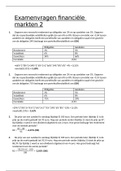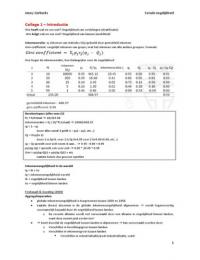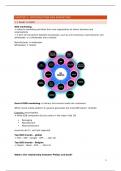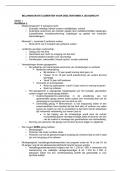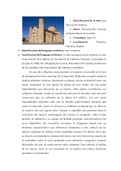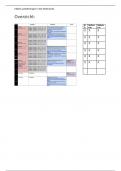GEN-21803
,Chapter 1: The Genetics Revolution in the
Life Sciences
After completing this chapter, you will be able to:
• Apply key terms
• Describe the way in which modern genetics developed
• List the main cellular constituents involved in gene expression and action
• Give some examples of how genetics has influenced modern medicine, agriculture and
evolution
Apply key terms
Ligase: can join two DNA molecules together end-to-end.
DNA polymerases: can make a copy of a single DNA strand by synthesizing a matching strand with
the complementary sequence of A’s, C’s, G’s, and T’s
Multifactorial hypothesis: The idea that continuous traits are controlled by multiple Mendelian
genes
Transformation: method to insert foreign DNA molecules into the genomes of many species,
including those of all the model organisms.
Quantitative trait locus (QTL): a genetic locus that contributes incrementally or quantitatively to
variation for a trait.
Regulatory elements: are specific DNA sequences to which a regulatory protein binds and acts as
either an activator or repressor of the expression of the gene.
Monogenic/Mendelian inheritance: refers to the kind of inheritance whereby a trait is determined
by the expression of a single gene or allele
Describe the way in which modern genetics developed
Genetics tries to understand rules that govern transmission of genetic information at different levels
,Mendel
1865: Mendel presented his law of inheritance;
traits are controlled by discrete factors now
known as genes
1900: Mendel rediscovered → new ideas and
questions
Key concept: Mendel demonstrated that genes
behave like particles and not fluids
“One gene one enzyme” hypothesis
The one-gene–one- enzyme model proposed
that genes encode enzymes that carry out
biochemical functions within cells. Tatum and
Beadle (1941) proposed this model based on
the study of the synthesis of arginine (an amino
acid) in the bread mold Neurospora crassa.
Each step is associated with a single gene and a
single enzyme.
1.2: After cracking the code: genetic analysis applied to a variety of biological
questions
A model organism is a species used in experimental biology with the presumption that what is
learned from the analysis of that species will hold true for other species, especially other closely
related species. Findings are extrapolated
Suitable model organism features:
I. Small organisms that are easy and inexpensive
II. A short generation time
III. A small genome is useful
IV. Organisms that are easy to cross or mate and that produce large numbers of offspring
Key concept: most genetic studies are performed on one of a limited number of model organisms
that have features that make them especially suited for genetic analysis
,List the main cellular constituents involved in gene expression and
action
Characteristics of DNA (double helix) that make it
suitable as carrier of genetic information
• Enormous capacity for data storage and diversity:
ATGC
o 4 different building blocks
o Efficient
• Replication: (hydrogen bonds)
o A=T
o GC
• Translation into form/function
• Stability
• Mutability
o Heritable mutations in genes
o Alleles → genetic variation (evolution)
3.000.000.000 bp, ~ 20.000 ‘genes’ (~1% of DNA)
80% = Regulatory functional elements
Many diseases are complex:
- Polygenic
- Affected by environment
- Genetic mutations outside protein-encoding region
- Genetic mutations within the gene may depend on interactions between genes (epistasis)
Key Concept The rediscovery of Mendel’s laws launched a new era in which geneticists resolved
many fundamental questions about the nature of the gene and the flow of genetic information
within cells. During this era, geneticists learned that genes reside on chromosomes and are made of
DNA. Genes encode proteins that conduct the basic enzymatic work within cells.
,Give some examples of how genetics has influenced modern medicine,
agriculture and evolution
1.3: Genetics today
- Investigating mutation and disease risk
o Tracing the origin of a new point mutation
o The number of new mutations increases with father’s age
- Adaptions to new pathogens, diet and climate
o GWAS: genome-wide association study
o Tibetans are genetically adapted to life at high elevation
,Key concept: Classical transmission genetics provides the foundation for modern medical genetics.
The integration of classical genetics and genomic technologies can allow the causes of inherited
diseases to be readily identified.
Key concept: Genome sequences of parents and their children clarify the factors that contribute to
new point mutations. Fathers contribute four times as many new mutations to their offspring as do
mothers. The number of mutations passed from father to his children rises with the age of the
father.
Some human population have lactase gene variants expressed in adults
People in Europe are adapted to drink milk as adults.
Simplified diagram of the lactase gene showing a regulatory element and protein coding region.
OCT1 is a protein thought to regulate expression of the lactase gene. SNP variants in the regulatory
element are found in some parts of the world. These SNPs are associated with OCT1 binding to the
element and expression of the lactase gene in adults.
Key concept: Evolutionary genetics provides the tools to document how gene variants that provide
beneficial effect can rise in frequency in a population and makes individuals better adapted to the
environment in which they live
,Chapter 2: Single-gene inheritance
After reading this chapter, you should be able to
• Apply the key terms of this chapter
• Explain single-gene inheritance ratios in terms of chromosome behavior at meiosis
• Apply the rules of single-gene inheritance to:
o Pedigree analysis in humans,
o Recognize patterns diagnostic of autosomal dominant, autosomal recessive, X-
linked dominant, X-linked recessive conditions
o Discover the genes affecting a specific biological property
o In controlled crosses, recognize phenotypic ratios diagnostic of single-gene
inheritance in haploids and diploids
• Calculate risk of descendants inheriting, a condition caused by a mutant allele in one or
more specific ancestors
Apply the key terms of this chapter
Single-gene inheritance: A single gene that can affect a trait
Alleles: Different forms/versions of one gene type (trait)
Genotype: The allelic combination of an individual
Phenotype: Physical manifestation of a genotype
Codon: a set of three consecutive nucleotides in the mRNA that specifies an amino acid in a protein.
Chromatids: two identical copies of DNA making up a duplicated chromosome
Self (self- pollination): is carried out by allowing pollen from a flower to fall on its own stigma.
Special type of mating
Dimorphism: if 2 allele occupies that gene's locus within a population. E.g. gender.
, Types of inheritance:
• Autosomal inheritance, based on variation of single genes on regular chromosomes
(autosomes)
• Sex-linked inheritance, based on variation of single genes on the sex-determining
chromosomes
• Cytoplasmic inheritance, based on variation of single genes on organelle chromosomes
Pure lines: for the phenotype in question, all offspring produced by matings within the members of
that line were identical.
Testcross: the cross of an individual of unknown heterozygosity (for one gene or more) with a fully
recessive parent
Tester: the recessive individual
Monohybrid cross: a genetic mix between two individuals who have homozygous genotypes, or
genotypes that have completely dominant or completely recessive alleles, which result in
opposite phenotypes for a certain genetic trait. Selfing the F1 individuals can be thought of as a cross
of the type Y/y × Y/y,
Monohybrid: a heterozygote for one gene
Polymorphisms: defined as the coexistence of two or more reasonably common phenotypes of a
biological property. A discontinuous genetic variation. Individuals fall in discrete classes.
Forward genetics: a strategy to understanding biological function starting with random single-gene
mutants and ending with their DNA sequence and biochemical function
Genetic dissection: the biological property in question is picked apart to reveal its underlying genetic
program, not with a scalpel but with mutants. Each mutant potentially identifies a separate gene
affecting that property.
Mutants: The heritable variants observed in an organism that differs from the wild type, individual
organisms having some abnormal form of a property.
Tetrad: The four haploid cells derived from a single meiosis.
Ascus: membranous sac
Codominance: A situation in which a heterozygote shows the phenotypic effects of both alleles
equally.
Incomplete dominance: A situation in which a heterozygote shows a phenotype quantitatively (but
not exactly) intermediate between the corresponding homozygote phenotypes. (Exact intermediacy
means no dominance.)
Haplo-sufficient: one gene copy (dose) has enough function to produce a wild-type phenotype
Haplo-insufficient: The single wild-type allele cannot provide enough product for normal function.
Null mutant allele will be dominant
Hemizygous: Gene present in only one copy in a diploid


